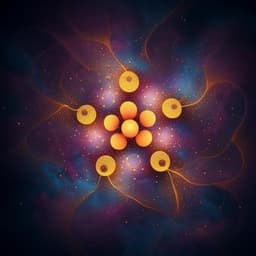
Engineering and Technology
3D printing of dynamic covalent polymer network with on-demand geometric and mechanical reprogrammability
Z. Fang, Y. Shi, et al.
Discover a groundbreaking 3D photo-printable dynamic covalent network that pioneers reprogramming of geometry and mechanical properties after printing. Conducted by a team of experts, this research showcases the potential for multiple products from a single print using advanced bond exchange reactions.
~3 min • Beginner • English
Introduction
The study addresses a key limitation in 3D printing of polymers: once printed, both geometry and mechanical properties are typically fixed, leading to a one print to one product paradigm. While DLP 3D printing enables high precision and rapid fabrication, its resin and crosslinking requirements restrict materials choices and post-print adaptability. Dynamic covalent chemistry can endow polymer networks with adaptability such as self-healing and plasticity-based shape reconfiguration without altering network topology. Separately, topology isomerizable networks (TINs) can switch between different topological states to tune macroscopic properties, but prior TIN approaches rely on entropy-driven redistribution in macromonomer-based systems that are not ideal for DLP due to low polymerizable functionality and high viscosity. The authors hypothesize that embedding two distinct and independently controllable exchange reactions—homolytic exchange for plasticity-driven shape reconfiguration and an enthalpy-driven heterolytic exchange that converts hindered urea to urethane for topology isomerization—would enable on-demand, post-print reprogramming of both geometry and mechanical properties from a single DLP print.
Literature Review
The paper situates its contribution within advances in 3D printing and dynamic polymer networks. Prior DLP and related 3D printing methods allow complex geometries but yield fixed shapes/properties post-curing. Dynamic covalent chemistries (e.g., Diels–Alder, disulfide, imine, β-hydroxyl esters, thioester–anhydride, thiourethane, boronate ester) have enabled self-healing and reprocessing in printed networks, yet not independent post-print reprogramming of shape and mechanical properties. Topology isomerizable networks (TINs) demonstrated programmable property tuning via entropy-driven topological homogenization but typically require macromonomers unsuitable for DLP. Prior work on plasticity in dynamic networks shows shape reconfiguration without property change via bond-exchange-enabled stress relaxation. The present work departs from entropy-driven TINs by introducing an enthalpy-driven topology isomerization (hindered urea to urethane) compatible with small-molecule photoresins suitable for DLP.
Methodology
- Network design: Prepared a DLP-printable resin comprising a hindered urea-containing bismethacrylate crosslinker (HUBM) and a hydroxyl-terminated acrylate comonomer at a 1:2 molar ratio (hindered urea:hydroxyl). Two comonomers were used: 4-hydroxybutyl acrylate (HBA, Mn = 144) and poly(propylene glycol) acrylate (PPGA, Mn = 475). Irgacure 819 photoinitiator at 3 wt% (and Sudan III photoabsorber 0.05% for printing) was included. Networks were formed via light-mediated free-radical polymerization.
- Rearrangement mechanisms: At ~80 °C, homolytic exchange of hindered urea bonds enables plasticity-driven, topology-preserving shape reconfiguration. At ~120 °C, heterolytic exchange between hindered urea and hydroxyl groups converts hindered urea to urethane and forms hindered amines, effecting enthalpy-driven topology isomerization and altering mechanical properties. Homolytic exchange is reversible; heterolytic exchange is irreversible but kinetically controllable by temperature/time to access intermediate topological states.
- Model compound kinetics: Synthesized n-hexyl-n-tert-butylethyl-urea and reacted it with equimolar 3-methyl-1-butanol at 120 °C without catalyst. Monitored 1H NMR peak evolution to quantify conversion αm from alcohol a→a′ using an internal standard (peak b). Assessed potential competing transesterification via two model studies: (1) ester + hindered amine + alcohol at 120 °C showed ~35% transesterification after 4 h; (2) ester + hindered urea + alcohol at 120 °C showed no detectable transesterification after 6 h by NMR/QTOF, indicating hydroxyls preferentially react with hindered urea over esters when both are present.
- FTIR monitoring in networks: Prepared HUBM-co-HBA networks, confirmed full acrylate conversion (disappearance of 809 cm⁻1 band). Thermally annealed at 80 °C or 120 °C, monitored carbonyl regions (1580–1780 cm⁻1). Quantified hindered urea→urethane conversion from integrated peak areas (urea at ~1635 cm⁻1; urethane overlapping ester at ~1725 cm⁻1) using procedures described in Supplementary Information.
- Stress relaxation and shape reconfiguration: Performed iso-strain (10%) DMA stress relaxation at 80, 100, and 120 °C to characterize homolytic-exchange-driven relaxation. Quantified permanent shape retention Rret = εfinal/εinitial over multiple 80 °C, 60 min reconfiguration cycles.
- Thermal and mechanical characterization: Measured Tg by DMA; tensile properties (modulus, strength, strain-at-break) at room temperature; swelling-based crosslink density (Flory–Rehner) to obtain Mc. Compared properties before and after isomerization (annealing at 120 °C up to 24 h). Verified gel fractions (>90%). Assessed stability of intermediate topological states after storage at room temperature for 2 weeks.
- DLP 3D printing: Used a bottom-up DLP setup with a commercial projector (10 mW cm⁻2), 20 s/layer exposure. Post-cured printed parts in a flood UV chamber (955 mW cm⁻2, 120 s). Resin viscosity ~127 mPa·s. Demonstrated printing of complex geometries. Implemented post-print shape reconfiguration at 80 °C under external deformation. Implemented spatio-selective heterolytic isomerization by immersing parts partially in 120 °C oil bath to create mechanical gradients, followed by compression tests under a fixed load (10 kg).
Key Findings
- Independent exchange pathways: Homolytic exchange activates at lower temperature (~80 °C) enabling permanent shape reconfiguration without changing network topology/mechanics; heterolytic exchange at higher temperature (~120 °C) converts hindered urea to urethane, driving enthalpy-based topology isomerization and mechanical property changes.
- Model reaction kinetics: Catalyst-free reaction of hindered urea with a primary alcohol at 120 °C reached ~100% conversion in ~4 h (1H NMR). Competing transesterification is suppressed in the presence of hindered urea: an ester + hindered amine system showed ~35% conversion in 4 h, while an ester + hindered urea system showed no detectable transesterification after 6 h (NMR/QTOF).
- Network-level conversion: In HUBM-co-HBA, FTIR showed minimal urea→urethane conversion at 80 °C (~10% after 12 h) but substantial conversion at 120 °C (~90% by ~8 h), confirming temperature-gated heterolytic exchange.
- Stress relaxation and shape reconfiguration: Under 10% iso-strain, networks nearly fully relaxed stress at 80 °C in ~60 min and at 120 °C in ~5 min. Shape retention Rret was ~90% in the first 80 °C, 60 min cycle and remained high over five cycles, demonstrating repeatable permanent shape reconfiguration.
- Property tuning with HBA: After 120 °C, 12 h annealing, Tg decreased from 99 °C to 83 °C, while modulus and tensile strength changed only slightly (1.16 ± 0.06 GPa to 1.12 ± 0.06 GPa; 55.5 ± 6.3 MPa to 53.1 ± 5.2 MPa), indicating limited tunability with HBA.
- Expanded tunability with PPGA: As-printed HUBM-co-PPGA exhibited two Tgs at −22 °C and 69 °C; after isomerization at 120 °C (24 h), Tgs merged to a single broad Tg at 14 °C. Room-temperature modulus dropped tenfold from 70 MPa to 7 MPa; strain-at-break increased from ~20% to ~55%. Swelling-based Mc increased from 186 ± 14 kg/mol to 271 ± 4 kg/mol, consistent with longer network strands post-isomerization.
- Printing demonstrations: Complex 3D objects were printed successfully by DLP. Post-print plasticity enabled transformation of a printed object (e.g., a lantern) into shapes difficult to print directly without internal supports (e.g., converting round-top to flat-top after printing). Spatio-selective isomerization created objects with spatially varying stiffness; the heated upper portion became compressible under a 10 kg load while the unheated lower part remained rigid.
- Stability and curing: Intermediate topological states are near-fully cured (gel fraction >90%) and stable over at least 2 weeks at room temperature; mechanical properties matched those of UV-chamber-cured samples at corresponding states.
Discussion
The results validate the concept that embedding two independently addressable exchange chemistries in a DLP-printable network enables decoupled and on-demand reprogramming of both form and function after a single print. Homolytic hindered urea exchange affords plasticity that reconfigures geometry without altering topology or mechanical properties, overcoming the fixed-shape limitation of conventional thermoset prints. The enthalpy-driven heterolytic conversion of hindered urea to urethane enables topology isomerization and substantial changes in thermal and mechanical properties when paired with an appropriate comonomer (PPGA), thereby overcoming the limited tunability of entropy-driven TINs that are incompatible with DLP resins. Demonstrations of support-free fabrication via post-print reconfiguration and spatio-selective property tuning highlight practical benefits for complex part manufacture and multi-material integration from a single precursor. The stability of intermediate topological states confirms that property programming is not a transient post-curing effect but a robust topological transformation.
Conclusion
This work introduces a DLP-printable dynamic covalent network exhibiting two independently controllable exchange reactions: homolytic hindered urea exchange for permanent, topology-preserving shape reconfiguration and heterolytic conversion of hindered urea to urethane for enthalpy-driven topology isomerization and mechanical property tuning. Using HUBM with PPGA as the comonomer achieves large, programmable shifts in Tg, modulus, and extensibility, enabling the paradigm of one print to multiple products. The approach simplifies multi-material integration and allows spatio-selective property patterning using a single resin. Future work may extend this material principle to other dynamic covalent chemistries to further broaden the range and rate of tunable properties, optimize kinetics to reduce annealing time/temperature, and explore applications in complex, multifunctional devices.
Limitations
- Limited tunability with HBA comonomer: isomerization led to modest property changes (Tg 99→83 °C, minor changes in modulus/strength), motivating the switch to PPGA for broader tunability.
- Thermal requirements and time: achieving high degrees of heterolytic isomerization required elevated temperature (120 °C) and extended times (hours; up to ~24 h for full effects in HUBM-co-PPGA), which may constrain throughput or substrate compatibility.
- Irreversibility of heterolytic exchange: while enabling stable programmed states, the hindered urea→urethane conversion is irreversible, limiting reversibility of property changes.
- Precision thermal control is needed for spatio-selective isomerization (e.g., partial oil bath immersion) to pattern properties post-print.
- The approach relies on UV-curable DLP printing; although post-print handling is solid-state, the initial printing step still requires handling of liquid photopolymer resins in a printing facility.
Related Publications
Explore these studies to deepen your understanding of the subject.







